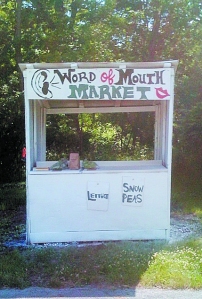
The Word of Mouth Market is now open for business!
First some rumor control: While it is true that I have given notice and will be moving my Genesee Graphics business out of its current location by the end of the month, I am not going out of business! I have been looking for a better location for the past 6 months, and am currently talking to one local landlord about a possible Main Street location. If that doesn’t work out, I may temporarily run the business from home until I find the right location.
The reason I need a new location is that I want to combine a farm market in the same location with the graphics business and therefore need a more visible and accessible location. I have planted around three acres of vegetables this spring and that is a lot more than I can eat myself! By combining the businesses I can save on labor costs by having one person supervise both operations.
I am not a big fan of self-service farm markets having tried that route with Strong’s World of Pumpkins in Caledonia for many years. Although 99% of people are honest and many will overpay for their produce, such operations inevitably attract thieves who will figure out a way to break into or carry off your money box. No fun!
In the mean time, however, since the early crops are coming in, I have opened a small self-service stand on the farm. (See picture.) The “Word of Mouth Market” will not be publicly advertised other than through this column, Facebook and e-mail. I am not looking to do a high volume business at this location for obvious reasons.
If you have heard about the market from any of these sources, or by word of mouth, you are welcome to come down the driveway and check it out. Currently we have some tasty snow peas, a good selection of lettuce and greens and some of Miss Amy’s flowers at reasonable prices. All produce has been grown without chemical herbicides or pesticides, although I have not registered as an official organic farm. (See my previous column for a discussion of that.) I have also installed a small refrigerator to keep some of the tender produce cool until you get there.
Enjoy!
P.S. Thanks to my daughter Corinna for the fancy sign!
